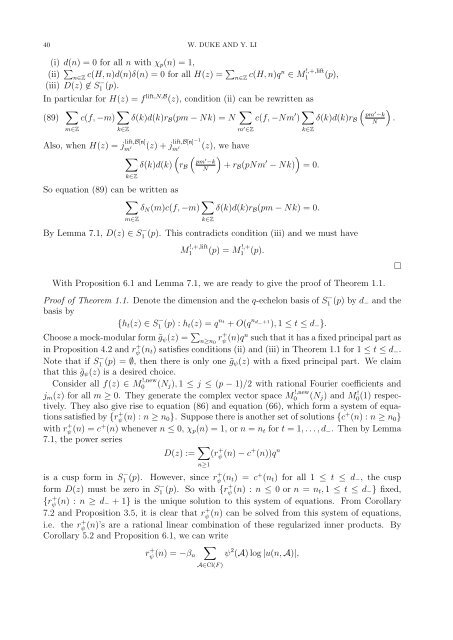Mock-modular forms of weight one - UCLA Department of Mathematics
Mock-modular forms of weight one - UCLA Department of Mathematics
Mock-modular forms of weight one - UCLA Department of Mathematics
You also want an ePaper? Increase the reach of your titles
YUMPU automatically turns print PDFs into web optimized ePapers that Google loves.
40 W. DUKE AND Y. LI<br />
(i) d(n) = 0 for all n with χ p (n) = 1,<br />
(ii) ∑ n∈Z c(H, n)d(n)δ(n) = 0 for all H(z) = ∑ n∈Z c(H, n)qn ∈ M !,+,lift<br />
1 (p),<br />
(iii) D(z) ∉ S1 − (p).<br />
In particular for H(z) = f lift,N,B (z), condition (ii) can be rewritten as<br />
(89) ∑ m∈Z<br />
c(f, −m) ∑ k∈Z<br />
Also, when H(z) = j lift,B[n]<br />
m ′<br />
∑<br />
δ(k)d(k)<br />
δ(k)d(k)r B (pm − Nk) = N ∑ m ′ ∈Z<br />
k∈Z<br />
So equation (89) can be written as<br />
∑<br />
c(f, −Nm ′ ) ∑ k∈Z<br />
(z) + j lift,B[n]−1<br />
m<br />
(z), we have<br />
(r ′<br />
( )<br />
)<br />
B + r B (pNm ′ − Nk) = 0.<br />
pm ′ −k<br />
N<br />
m∈Z<br />
δ N (m)c(f, −m) ∑ k∈Z<br />
δ(k)d(k)r B (pm − Nk) = 0.<br />
δ(k)d(k)r B<br />
(<br />
By Lemma 7.1, D(z) ∈ S − 1 (p). This contradicts condition (iii) and we must have<br />
M !,+,lift<br />
1 (p) = M !,+<br />
1 (p).<br />
)<br />
pm ′ −k<br />
.<br />
N<br />
With Proposition 6.1 and Lemma 7.1, we are ready to give the pro<strong>of</strong> <strong>of</strong> Theorem 1.1.<br />
Pro<strong>of</strong> <strong>of</strong> Theorem 1.1. Denote the dimension and the q-echelon basis <strong>of</strong> S − 1 (p) by d − and the<br />
basis by<br />
{h t (z) ∈ S − 1 (p) : h t (z) = q nt + O(q n d − +1<br />
), 1 ≤ t ≤ d − }.<br />
Choose a mock-<strong>modular</strong> form ˜g ψ (z) = ∑ n≥n 0<br />
r + ψ (n)qn such that it has a fixed principal part as<br />
in Proposition 4.2 and r + ψ (n t) satisfies conditions (ii) and (iii) in Theorem 1.1 for 1 ≤ t ≤ d − .<br />
Note that if S1 − (p) = ∅, then there is only <strong>one</strong> ˜g ψ (z) with a fixed principal part. We claim<br />
that this ˜g ψ (z) is a desired choice.<br />
Consider all f(z) ∈ M !,new<br />
0 (N j ), 1 ≤ j ≤ (p − 1)/2 with rational Fourier coefficients and<br />
j m (z) for all m ≥ 0. They generate the complex vector space M !,new<br />
0 (N j ) and M 0(1) ! respectively.<br />
They also give rise to equation (86) and equation (66), which form a system <strong>of</strong> equations<br />
satisfied by {r + ψ (n) : n ≥ n 0}. Suppose there is another set <strong>of</strong> solutions {c + (n) : n ≥ n 0 }<br />
with r + ψ (n) = c+ (n) whenever n ≤ 0, χ p (n) = 1, or n = n t for t = 1, . . . , d − . Then by Lemma<br />
7.1, the power series<br />
D(z) := ∑ n≥1<br />
(r + ψ (n) − c+ (n))q n<br />
is a cusp form in S1 − (p). However, since r + ψ (n t) = c + (n t ) for all 1 ≤ t ≤ d − , the cusp<br />
form D(z) must be zero in S1 − (p). So with {r + ψ (n) : n ≤ 0 or n = n t, 1 ≤ t ≤ d − } fixed,<br />
{r + ψ (n) : n ≥ d − + 1} is the unique solution to this system <strong>of</strong> equations. From Corollary<br />
7.2 and Proposition 3.5, it is clear that r + ψ<br />
(n) can be solved from this system <strong>of</strong> equations,<br />
i.e. the r + ψ<br />
(n)’s are a rational linear combination <strong>of</strong> these regularized inner products. By<br />
Corollary 5.2 and Proposition 6.1, we can write<br />
r + ψ (n) = −β ∑<br />
n ψ 2 (A) log |u(n, A)|,<br />
A∈Cl(F )<br />
□
















